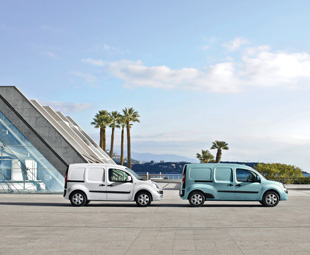Green workhorse

In the global quest to promote low-carbon transport, all sectors of the industry, light commercial vehicles (LCVs) included, are under pressure to support “green” mobility. CLAIRE RENCKEN takes a look at a courier company that is doing just that.
Dual-fuel vehicles typically reduce carbon emissions by up to 14 percent, while electric and hybrid vehicles are especially suited for driving in stop-and-go city delivery. Deutsche Post DHL has been involved in many alternative drive system pilot projects over the years. These include hybrid engines, electric vehicles, natural gas and biogas vehicles, as well as dual-fuel and aerodynamic modifications.
In mid-2013, Deutsche Post DHL began transforming Bonn, where the Group is headquartered, into Germany’s first city with a carbon-free vehicle concept for mail and parcel delivery. All parcel delivery in the city and surrounding areas will be changed to electric vehicles. By 2016, over 140 electric vehicles will be in use, including several Renault Kangoo ZE electric vans.
Manoella Wilbaut, head of global commercial developments for DHL’s automotive sector, says: “We are at the forefront of testing alternative drives: electric vehicles are particularly suitable for urban delivery on defined routes, where we can take full advantage of their CO2 efficiency, low noise levels and cost-effectiveness.
“The Renault Kangoo ZE is a vehicle we currently use successfully in several European countries. Renault is a leading reliable global partner in that field. We are keen to drive the change in the logistics industry and look forward to a future expansion of the collaboration with Renault.”
Uwe Hochgeschwurtz, corporate sales director, senior vice president at Renault, is just as positive about the partnership: “Renault, as one of the leaders in electric vehicles in Europe, is proud to support DHL’s global operations. With the Kangoo ZE, Renault supplies a perfect tool for urban deliveries all over the globe. With this agreement, Renault and DHL will accelerate the implementation of Kangoo ZE vehicles in more countries, and on other continents.”
The Renault Kangoo ZE and Renault Kangoo Maxi ZE were launched in Europe in 2011. These all-electric versions of the Kangoo maintain the functional qualities of their internal combustion engine counterparts – they have the same load volume, the same payload and offer the same comfort.
Revealed at the Hanover Motor Show in 2010, the Kangoo ZE was voted International Van of the Year in 2012. It was the first electric vehicle to win this title.
The Kangoo Maxi ZE, revealed at the Geneva Motor Show in 2011, is a longer version of the Kangoo ZE With a wheelbase extended by 40 cm, the van has a total length of 4,6 m. It is available in two versions: as a two-seater or as a five-seater combi. The first version is designed to carry goods. It has two seats, with optimum loading capacity, and a volume of up to 4,6 m3 (1,1 m3 more than the Kangoo ZE). It can accommodate a load length of up to 2,9 m and a height of 1,82 m.
The combi version of Kangoo Maxi ZE is equipped with a rear bench for carrying up to five people. A vehicle of modular design, it can take on four different layouts. The rear bench folds away into the floor to free up load capacity of almost 3,4 m3.
The Kangoo Maxi ZE is available in a choice of nine colours, but customers can also order it in their company’s colours.
Vehicles in the Renault Kangoo ZE range are immediately identifiable as all-electric, with chrome-finish ZE badges at the rear and on the side panels, no exhaust pipe and a flap at the front. This flap is used to charge the vehicle from a wall-mounted charging station; an operation that takes between six and nine hours. A 30-minute fast charge, to recover 80 percent of the battery range, will be available at a later date.
Under the bonnet is an electric motor boasting 44 kW, the equivalent of 60 hp. It runs on a lithium-ion battery, which is placed under the floor and has an energy capacity of 22 kW/h.
The vehicle range – 170 km over a new European driving cycle (NEDC) combined cycle – may vary in line with conditions of use, such as driving style, temperature, topography and speed. With maximum torque of 226 Nm available from start-up, strong acceleration and pick-up from low engine speeds, and no noise or gear changing, the vehicle sets new standards in performance and driving comfort.
To manage vehicle range, the dashboard was redesigned to include a new man-to-machine interface, informing the driver of the remaining battery charge and range.
An eco-driving system, to preheat the vehicle during charging, has also been developed. To further reassure customers and optimise range, Renault is marketing a range of connected services for drivers (Connected Pack) and fleet managers (Fleet Asset Management).
Although these vehicles are currently not available in South Africa, hopefully we can look forward to them being marketed here in the near future.
Published by
Focus on Transport
focusmagsa




